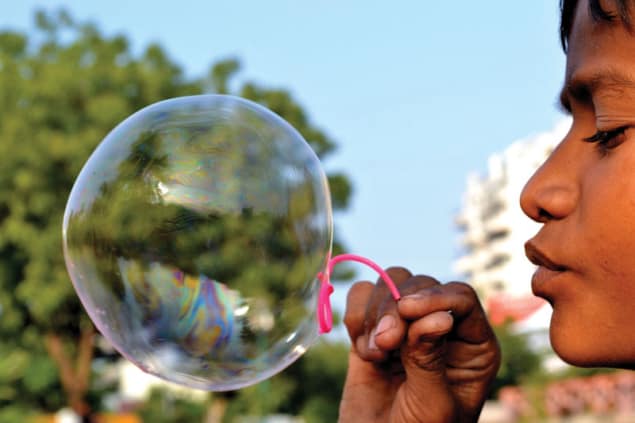Books on bubble physics, quantum exiles and arty photos of particle accelerators, reviewed by Margaret Harris

The joy of bubbles
Most of us spent several happy hours of our childhood blowing soap bubbles. Some of us, however, never grew out of it and, judging by his new book Fizzics: the Science of Bubbles, Droplets, and Foams, F Ronald Young is clearly one of them. A retired lecturer at London’s Watford College, Young has spent his career studying various bubble-related phenomena and he has previously written textbooks on cavitation and sonoluminescence. Fizzics, however, is an entirely different beast. Thanks to Young’s amiable prose, reading it is almost as relaxing as a bubble bath, and at just over 100 pages, it is almost as light and airy as its subject matter. The downside to such brevity, of course, is that each topic – from the cloud chambers used in early particle-physics experiments to the frothy head on a pint of beer – is only explored to the depth of a soap film.
- 2011 Johns Hopkins University Press £13.00/$25.00pb 136pp
Quantum exiles
In May 1933, shortly after the Nazis came to power in Germany, the cathode-ray pioneer Philipp Lenard penned an article for the party newspaper Völkischer Beobachter. In it, Lenard – who had won the Nobel Prize for Physics in 1905, Einstein’s “miracle year” – lamented “the massive infiltration of the Jews into important posts in universities and academies”. Einstein, he added, was only “the most obvious example of this damaging influence”. Eight decades have not dulled the ugliness of Lenard’s antisemitism, but it is true that many of the leading lights of 20th-century physics were indeed Jewish. As Gordon Fraser‘s book Quantum Exodus: Jewish Fugitives, the Atomic Bomb, and the Holocaust shows, the list of Jewish or part-Jewish physicists in pre-war continental Europe was long and illustrious, with the likes of Bethe, Bohr, Frisch, Meitner, Pauli, Teller, Wigner and Von Neumann joining Einstein in the top flight. Fraser deals competently with these luminaries’ relatively familiar stories, while also incorporating the experiences of many lesser-known exiles. The latter group includes the likes of Gertrude Scharff, a PhD student who fled to London in 1935 after finishing her dissertation at the University of Munich; Franz (later Francis) Simon, a Berlin-based cryogenics expert who moved to Oxford in 1933; and the massive one-quarter of all German university physics teachers who left in 1933 alone. The mass departure of these ordinary physicists cut deep into Germany’s scientific establishment, and probably did more damage on aggregate than the absence of a few superstars. As Fraser points out, Germany’s loss would prove to be the Allies’ gain, since émigré physicists great and small went on to play vital roles in the US atomic-bomb programme. There is, however, a downside to packing the stories of so many different people into a single book. Parts of Quantum Exodus have a distinctly “laundry list” flavour, while frequent hops between the book’s component stories (and time periods) can be hard to follow. Still, the constituent parts of Fraser’s book make for fascinating reading, even if they never quite gel into a single cohesive narrative.
- 2012 Oxford University Press £25.00/$45.00hb 280pp
Accelerator photography
Particle accelerators are amazing examples of human ingenuity. They are also rather beautiful. Both of these qualities are highlighted in Time Machines, a new book of black-and-white photographs by Stanley Greenberg, whose previous work includes photos of New York City’s water system. For this book, Greenberg has drawn his inspiration from accelerator and detector facilities around the world, capturing images of the Cockcroft–Walton accelerator at Japan’s KEK facility, dipole magnets at CERN’s Large Hadron Collider and calorimeters at DESY in Germany, among many others. Several of the photos have an intimate, behind-the-scenes feel, including a close-up view of a detector at the Sudbury Neutrino Observatory in Canada, which Greenberg obtained by strapping himself into a harness and being lowered into a 200 m cavity. A photo of the “horn” on Fermilab’s MiniBooNE neutrino experiment is also nicely composed, with the horn’s curvature and central void echoing illustrations of black holes. However, not every photo in the collection is so successful, and artistically minded readers might query Greenberg’s decision to use brooding monochrome to depict these often brightly coloured machines.
- 2011 Hirmer £39.95/$59.95hb 176pp



